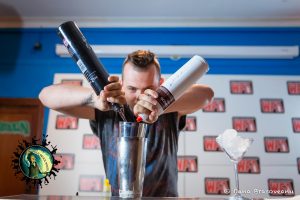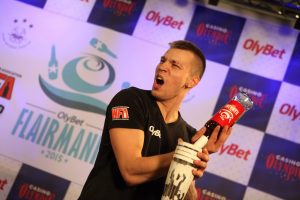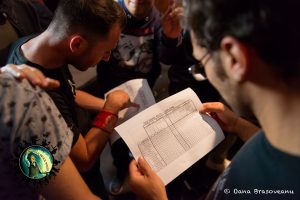More and more flair competitions are springing up all the time, each with their own styles, specific rules and requirements. While you could take a single routine and enter any you want, lets see what can be done to maximise your score with the minimum amount of effort.
1: Know the Score With the Event.
As soon as you consider entering a competition you should find out exactly what the rules and conditions of entry are. How much time do you have on stage to figure out how long should your music be? Do you need entrance music like a pro wrestler as you walk to the bar? Is there a main routine and a “bonus segment” (more on those later)?
What drinks do you need to make? If there are set drinks what is the Exact way to make them. Check this with the organiser. Are there any restrictions on which bottles you can use? Be sure you know the event rules inside out and you’ll know how to focus your routine. There could even be a pour test, so make sure you know what spout is being used or bring your own.
2: Categories.
Nowadays, you can win prizes not just for 1st, 2nd, 3rd place, which is great especially for newer bartenders. There may well be a mixology segment with its own prize, Entertainment, Technical, maybe even more.
If you’re not the most experienced bartender in the competition, with the biggest moves, you could still be in the running for entertainment or best cocktail category for example, which will really help to build your profile and confidence for future competitions. Play to your strengths and you’ll see success sooner than you think.
3: Cocktail Making Rounds.
Cocktail making rounds will give you the opportunity to shine, as you can test the recipes ahead of time with more experienced bartenders you know and hone your recipe.
Try to bring everything you need to make these drinks, don’t assume the venue will have anything for this – bring your own glassware (and spares), your spirits and liqueurs, juices and garnishes. Don’t leave anything to chance. Also – try not to pour your juices from cartons, so maybe toss a store and pour in your bag too.
4: Know your Sponsors.
Making sure you know who is sponsoring the competition and practicing with the specific bottle or product will work greatly in your favour. A lot of competitions these days are putting in a “percentage of sponsor flair” category, which means that you need to flair with the sponsor bottle for a specific amount of time (normally 10% of your routine). Always try and go above and beyond the required time to score the points and to give yourself a buffer zone to ensure you reach the required time.

Make sure you showcase the sponsors products to the best of your ability. There is sometimes a special prize from the Sponsors for the competitor that used the sponsors product the best. The Sponsors pay the money for the competition so make sure you show your respect on stage.
5: Perfect Practice.
Make your practice sessions as hard as you can, and by that I mean the worst possible situation, way worse than you should ever face on stage. At the competition you’ll make sure that your bottles are clean, dry and not sticky of course… but what if your first bottle either breaks or spills over your rail?
I used to practice with a bowl of water with some dishwasher soap in it, and completely soak my bottles for practice. They were slippery and wet, and horrible to flair with, but it can be done. By doing this (and you’ll quickly be able to do your whole routine with soaked bottles), you’re giving yourself an insurance policy incase things go wrong.
Also try flairing in the dark, and when you’re good at it, have someone shine a light in your eyes at the same time. Especially if the venue has a stage, you might find that your vision is severely impaired during your routine, so you might as well be ready for it.
Lastly, and this might sound stupid – practice in the same clothes you’ll be wearing. See number 8.
6: Be Entertaining.
This is probably the biggest tip here.
Smile.

Thats it. So many bartenders look nervous, intense or bored when they flair, but you can easily fix this by flairing while watching yourself in a mirror. Don’t watch your hands, make eye contact with yourself, and just use your peripheral vision to watch your objects.
It will do a couple of things – you’ll be more aware of your facial expressions, and you’ll also be forced not to look at your bottles and tins the whole time. Strangely enough, this is how I learned to flair blindfolded – it sounds stupid but you take the focus off the items and just know where they’re going. It also allows you to keep eye contact with your guests and hold a conversation while flairing in the long run, which is really impressive for a bartender to do.

You can of course include other entertaining elements to your routine, I personally use magicians flash paper for fire effects in a few ways (check that you won’t be disqualified if you want to try this), use a track that the audience will interact with and sing along rather than a heavy dance track, which will make the judges see them having a good time. There are plenty of little bits you can add – but they have to suit you!
7: Advanced Rules.
Find out what the deduction points are for a drop, spill, break, missing drink/ingredient, missing sponsor flair. Check to see how much you might be deducted for each mistake and if you can be deducted a lot for making mistakes ease back on the big technical moves and aim for a smooth, safe routine to avoid penalties. If they’re not marking down for those things, or the penalties are very small, go for your life and bring the big guns!
8: Dress Rehearsal.
I know, I know, it sounds completely stupid. But do it. Here are a couple of reasons.
If you’re competing in an event which requires you to wear a work uniform for example a bartender challenge at TGI Friday’s you will be wearing a long apron and possibly long shirt sleeves. Can you turn quickly enough, can you stall a bottle on your forearm with your arms covered? Might as well find out before the day. Are you going to have a bar blade pouch on your belt that could catch your arm or bottle? Will wearing a hoodie interfere with your shadow passes? Is your footwear going to make you slip where you perform?

The last thing you want is to have an unexpected ‘Wardrobe Malfunction’ in the middle of your routine, and practicing in your ‘costume’ may even show you some new possibilities like apron catches or Tom Dyer’s old school baseball cap stall (surely that king of the ring routine must be on Youtube by now).
9: Know your Music.
While I’ve picked up a track on the way to a competition before, if you know the routine length you can put in markers at specific points. If you miss the one minute left call (or the compare forgets, that happens too) will you know your music enough that you end with completed drinks? Or will you have a glass of ice on the bar, with half a drink in the shaker.
I have literally had a Countdown clock for the last 30 seconds on my track, so I don’t need to rely on anyone else. I can make a good drink in 30 seconds if I have to, but hopefully I’ll at least have iced the glasses by then!
10: Complete Your Drinks.
Don’t throw the easy points away.
Make sure all of your drinks are completed, poured to the right level, sat on a bevnap, with the right straws and garnishes. At the end of the day flair is one aspect of bartending, but not one that is as important as making quality drinks.

Why on earth do you think you will get more points from bouncing a bottle off your arm one more time, than you will get from doing the absolute most basic requirement of a bartender, which is… making your drinks.
In fact, make more effort than the other guys, have more elaborate garnishes on your drinks, which can be prepared before your routine so they don’t take up a second of your flair time.
What have I missed here? I’d love to hear your tips in the comments below.
David ’Scooby’ Sangwell is a 15 year bartender, manager and trainer with experience across the UK, Europe and the Middle East, who writes about cocktails, flair and bar culture at http://BartenderHQ.com


